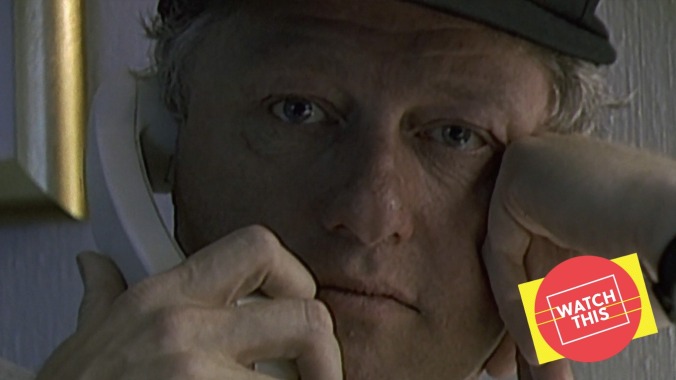Bill Clinton is a supporting character in this inside look at his campaign for the presidency

Watch This offers movie recommendations inspired by new releases, premieres, current events, or occasionally just our own inscrutable whims. This week: With Jon Stewart’s Irresistible headed for home-viewing platforms—and with November 3 on the horizon—we’re looking back at other films about elections or political campaigns.
The War Room (1993)
Shot over most of 1992, The War Room offers a behind-the-scenes account of how Bill Clinton, then the governor of Arkansas, successfully unseated George H.W. Bush for the American presidency. Yet anyone seeking a comprehensive overview of that election year should consult a textbook instead. Chris Hegedus and D. A. Pennebaker, the veteran documentarians who directed the film, don’t take us blow by blow through either the primary or the general election. Though headlines from major newspapers cursorily identify some of the flashpoints of the race, plenty of others—from Clinton’s insistence that he didn’t inhale when he smoked marijuana to his tide-shifting, saxophone-playing appearance on The Arsenio Hall Show—receive no mention whatsoever. Instead of summarizing what would have been very fresh in audience’s minds (The War Room opened, after all, less than a year after Clinton took office), Hegedus and Pennebaker focus on what news cameras weren’t capturing and broadcasting into American homes every day—namely, the mechanics of a presidential campaign, independent of the spectacle of stump speeches and rallies.
The War Room is first and foremost a triumph of access, shaped by both the privileges afforded its filmmakers and by the limitations of those privileges. Pennebaker had experience chronicling a political race; three decades earlier, he edited the trailblazing direct-cinema documentary Primary, about John F. Kennedy and Hubert Humphrey’s competing bids for the Democratic nomination. But while The War Room adopts the same vérité shooting style, observing events like a fly on the wall rather than sitting its subjects down for interviews, the candidate himself doesn’t appear much this time, save for an early T-shirt-and-shorts cameo and some TV footage. With the capacity to follow Clinton largely restricted by the DNC, the movie’s focus inevitably drifts to and settles on the men running his campaign: lead strategist James Carville and Communications Director George Stephanopoulos. And you can pretty much pinpoint the exact moment the filmmakers realized that their movie wasn’t out on the campaign trail but in the eponymous, nondescript Little Rock office where Carville and Stephanopoulos made key decisions.
Though it opens with the Gennifer Flowers scandal, The War Room mostly zeroes in on less sensational obstacles, offering something like the nuts and bolts of the campaign. We see the strategists debate how to shave a few seconds off an attack ad built around Bush’s backfiring “Read my lips” sound bite; dig up a potentially damning tidbit regarding their opponent’s campaign materials, only to discover it’s less damning than they hoped; and question the particular positioning of a podium on debate night. Process wonks will eat all of this up, but the real draw is the personalities; this is one of those documentaries where you sometimes can’t believe you’re watching real people as opposed to actors reciting written dialogue. At the center is Carville, whose long career as a consultant and TV pundit largely rests on the year of his life depicted here. Though the Ragin’ Cajun has become a caricature of himself since (and the subject of numerous fictionalizations and parodies), he’s a genuinely fascinating character in The War Room: amused, irked, engaged, impassioned, always quick with a folksy quip. For example, he says of Bush, “He’s so yesterday, that if I think of an old calendar, I picture his face.”
Of course, Carville and his victory are pretty yesterday now, too. That’s the thing: However close a documentary comes to capturing history as it happens, it will always become a time capsule. There are tons of accidentally prescient moments in The War Room, from an offhand remark about Roger Ailes to the appearances by Republican strategist Mary Matalin (who Carville would eventually marry) to a disturbing scene where Stephanopoulos tries to intimidate and coerce a reporter out of chasing a story about an alleged affair of Clinton’s. In other ways, the film’s vision of political maneuvering looks rather quaint today; in 2020, it’s harder to imagine a campaign manager worrying so much about their boss coming across as truthful and not embellishing their accomplishments. Ultimately, though, the film fascinates as much for what it doesn’t reveal as what it does: Rather than attempt a full portrait of this significant moment in American politics, Hegedus and Pennebaker train their lens on one interesting corner, finding a rich character study inside of an involving procedural. Good luck getting that from a textbook.
Availability: The War Room is currently streaming on HBO Max, The Criterion Channel, and Kanopy. It can also be rented and purchased digitally from Amazon or iTunes.